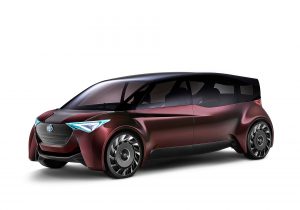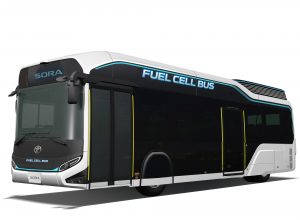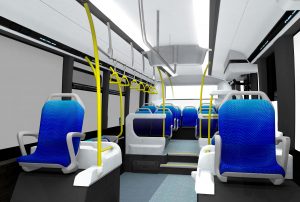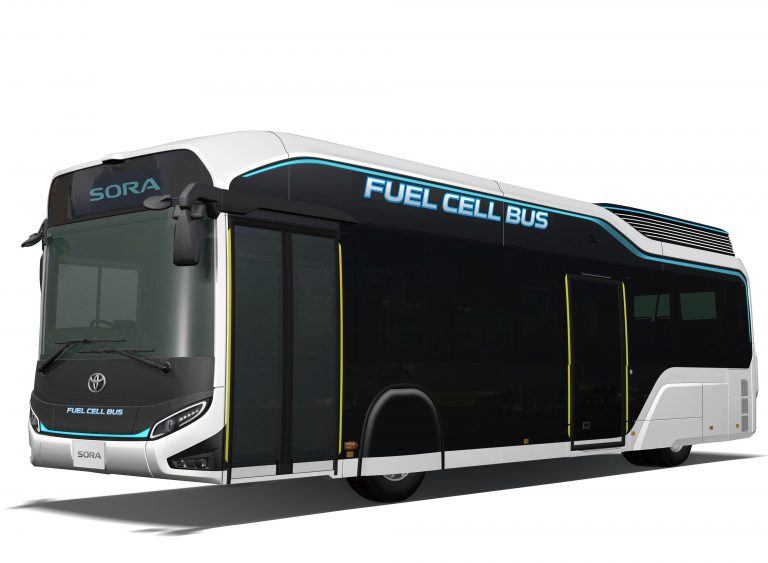Toyota Explores the Future Potential of Hydrogen Fuel Cell Technology with new Premium Car and Bus Concepts at the Tokyo Motor Show
A premium saloon with a flexible interior and bus that can serve as an emergency power supply as well as accessible public transport are contrasting Toyota concept vehicles with a common clean energy core, set to be unveiled at the Tokyo motor show next week (25 October). The Fine-Comfort Ride car and Sora bus are both hydrogen fuel cell vehicles, demonstrating the great opportunities the technology offers for designing radical new electric-powered vehicles for a future low carbon society.
Toyota Fine-Comfort Ride Concept
More Fine-Comfort photographs can be downloaded here.
The Fine-Comfort Ride is a fuel cell vehicle that envisions mobility in a low-carbon society, making advanced use of hydrogen and renewable energy. It has been conceived as a “new form of premium saloon” with a flexible layout of a kind only possible in electric-powered vehicles. It can also make use of a large amount of electric power, using hydrogen as the source of energy.
The vehicle offers excellent environmental performance, producing no CO2 or “substances of concern” (SoC) when driven, and the convenience of a generous cruising range and a hydrogen refuelling time of around three minutes.
The cabin section of the body has a diamond shape and is wider in all dimensions from the front to centre, before narrowing towards the rear. This maximises space for the second row seats and allows for an aerodynamically efficient design.
The flexible layout is a unique benefit of using electric power. Using in-wheel motors means the wheels can be positioned at the very corners of the vehicle, while an underbody cover helps achieve high running stability and quietness appropriate for a premium saloon.
The vehicle embraces the idea of future mobility being more than simply “a ride,” but providing additional value. The car has an Agent function and a touch display arranged around the driver and the passenger seats. The seats have flexible adjustment to suit different personal postures and the displays give everyone on board easy access to information. The seating can be adjusted so Fine-Comfort Ride can be used as an individual space, or an area where more people can communicate.
The car runs quietly and smoothly and makes full use of the high electricity generating capacity of its hydrogen fuel. The interior has a full range of equipment and the car can achieve a cruising range of more than 600 miles (Japan JC08 test cycle).
It is a six-seater vehicle, measuring 4,830mm long, 1,950mm wide and 1,650mm high, with a 3,450mm wheelbase.
Toyota Sora FC bus concept
More Sora FC bus photographs can be downloaded here.
The presentation of the Sora fuel cell bus previews Toyota’s plans to launch commercial sales of a model based on the concept in 2018. It expects to introduce more than 100 Sora, mainly in the Tokyo metropolitan area, ahead of the Tokyo 2020 Olympic and Paralympic Games.
The name is acronym for Sky, Ocean, River, Air – representing the earth’s water cycle.
Development of the concept was guided by two ideas: to make best use of the characteristics of the fuel cell unit and to enhance the comfort of passengers.
Toyota’s aim is to create a bus that works for the world and for people, is kind to the environment and can contribute to communities beyond its role as a means of transport.
It uses the Toyota Fuel Cell System that was engineered for the Mirai fuel cell saloon. This delivers superior environmental performance, emitting no CO2 or SOCs when operating. It is also equipped with a high-capacity external power supply system, with maximum output of 9lW and electricity supply of 235kWh1. This allows the Sora to serve as an emergency power source, for example to help provide relief and support in natural disasters.
Because the bus is designed to be used by large and varying numbers of passengers at any given time, Toyota paid close attention to convenience, safety and peace of mind, aiming to give all occupants a pleasant experience and encourage regular bus use.
The interior is fitted with horizontally arranged seats with an automatic storage mechanism to provide space for pushchairs or wheelchairs or extra seating, as required.
Eight high-definition cameras inside and outside the vehicle provide peripheral monitoring, detecting pedestrians and cyclists in the area around the vehicle and warning the driver with sound and image alerts.
A control function suppresses sudden acceleration, so the bus pulls gently away from standstill, taking the safety of standing passengers into account. With no gearshifts required, there is no uncomfortable lurching effect.
Automatic arrival control detects a guideline on the road surface and uses automatic steering and deceleration to bring the bus to a halt with three to six centimetres clearance from the stop, and within a 10 centimetre range ahead of or behind the stop. This makes boarding or alighting from the bus easier for passengers using wheelchairs or with pushchairs.
Bus transportation capability, speed, punctuality and convenience are boosted by ITS Connect. This uses vehicle-to-vehicle and vehicle-to-infrastructure communications to support safe driving, together with systems that support bus convoys and priority at traffic signals.
The Sora’s design has stereoscopic shape that is significantly different from the hexahedron – box shape – of conventional buses. This and the use of LEDs for the front and rear lights make it instantly recognisable.
Principal specifications
| Overall length (mm) | 10,525 |
| Overall width (mm) | 2,490 |
| Overall height (mm) | 3,340 |
| Passenger capacity – seated | 22 |
| Passenger capacity – standing | 56 |
| Total passenger capacity | 78 |
| FC system | Toyota FC Stack (solid polymer electrolyte) |
| Maximum FC output | 153bhp/114kW x 2 units |
| Electric motor type | AC synchronous |
| Maximum motor output | 152bhp/113kW x 2 units |
| Maximum motor torque | 335Nm x 2 units |
| High pressure hydrogen tanks – number | 10 |
| Nominal working pressure | 70MPa |
| Tank internal volume (litres) | 600 |
| Drive battery – type | Nickel-metal hydride |
| External power supply system – max. output/supply | 9kW/235kWh1 |
1The power that can be supplied and the power amount may differ, depending on the performance of the power supply unit, amount of hydrogen remaining, and power consumption.






